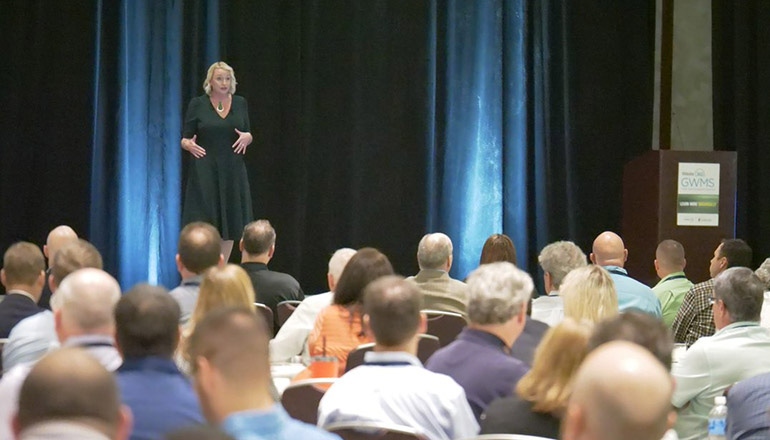Waste and Recycling: An Industry Under Society’s Microscope
During her GWMS 2020 keynote, Waste Management’s Tara Hemmer reflected on the evolution of solid waste and what it will take to drive the industry forward.

Think back to 30—even 40—years ago. The solid waste industry was once known for its behind-the-scenes, “invisible” work. Now, conversations around landfills, recycling and the call for zero waste and sustainable business practices have put the waste and recycling industry under society’s microscope, with society leaning on this industry to solve some of its greatest challenges yet.
That’s at least how Tara Hemmer, senior vice president of field operations for Waste Management’s southern tier, sees it.
During her keynote at Global Waste Management Symposium (GWMS) 2020 in Indian Wells, Calif., Hemmer pointed out that the industry has gone through a tremendous transformation over the last 30 years. With the advent of Subtitle D landfills and engineering solutions, she says the industry continues to successfully revamp how waste is collected, how it’s handled and what it ultimately becomes at the end of its life.
“While we’ve made dramatic changes over the last 30 years, the next 30 are pivotal,” she told GWMS attendees.
Hemmer pointed to millennials and Gen Z as the visionary generations that are the pioneers of change. And they are acting boldly to demand businesses, politicians and the waste and recycling industry actively join them in advocating for the planet.
“Our planet is a precious commodity, and the work that we all do will play a critical role in how we reshape our communities for the future. What we do matters,” stressed Hemmer. “My hope for today is that we’ll walk away with a deeper understanding of how we arrived at this crossroads. I want you to leave here feeling inspired, and the only way to do that is to tap into your passion. We’re all here because we care about the future of this industry. So, challenge one another and bring those difficult topics to the forefront.”
The Evolution of the Industry
Before looking forward, Hemmer reminded GWMS attendees how far the industry has come.
Hemmer started off her career in solid waste 25 years ago as an engineer. At the time, she said, the industry was clearly defined and anchored by a collection and disposal model. So, communities generated trash and really weren’t overly concerned with how their trash got collected.
“They knew we would pick up their waste and take it to a landfill,” she explained. “They probably didn’t realize or care how the landfill was engineered or what its lifecycle would be.”
And 25 years ago, recycling was only beginning to be discussed.
Then, in the early 2000s, the environmental sustainability movement started to take root. The definition of sustainability was tied to the environment and became synonymous with going green.
“Our customers began expressing concerns about the need to preserve natural resources, landfill air space and improved recycling across the United States,” noted Hemmer. “In time, the industry started investing heavily in renewable energy at our landfills. And Waste Management started investing heavily in natural gas collection trucks—the start of the closed loop in our collection of materials processes.”
Now, in 2020, businesses are increasingly taking a leadership role in how the world thinks about sustainability. Communities across the country are also thinking differently about the materials that the industry collects and handles.
Additionally, emerging trends, like the shift from brick and mortar to e-commerce, have transformed waste collection processes. Today, the industry handles an abundant electronics stream and follows safe disposal practices for materials like lithium-ion batteries. Recyclers today also deal with flexible packaging containing a multitude of plastic types in a singular pouch.
“New solutions are needed to address these trends around us, and there is no one-size-fits-all approach when it comes to creating solutions for these waste types,” explained Hemmer. “For now, landfills remain the most cost-effective, scalable and sustainable method for solid waste in North America, especially when there are renewable energy or renewable natural gas facilities onsite.”
However, expanding landfills in communities that need it most is becoming increasingly difficult, she said. One solution, according to Hemmer, is building out new infrastructure in those markets. And because landfills are facing increased scrutiny when it comes to greenhouse gas emissions and pressures related to leachate outlets, the industry must search for next-generation technology to implement.
When thinking about how the industry does business today, Hemmer listed four global themes—or macrotrends—that she believes will shape the future of the industry.
1. The rise of cities: Urbanization is a trend that is growing, explained Hemmer, with climate change impacting where people will live. “Rising populations mean an increase in solid waste generations. That puts the onus on us to keep up the pace with this rising demand,” she said.
2. Local versus national: Hemmer explained this trend is more about what local governments are doing to pick up the mantle that had once been held at the national level. For instance, she pointed out that cities are starting to examine what makes the most sense to recycle. An area where cities and states continue to lead is organics and food waste, she added.
3. Our planet, our resources: “How can our industry respond to and address climate change? The science is clear. Climate change is happening. Period, full stop. Mankind has had a big impact in exacerbating that,” emphasized Hemmer, noting that the industry must focus on mitigating the impacts of climate change and how to return resources so they can be made into something else.
4. Corporate social responsibility, or social impact: The business world is changing in large part because of millennials and soon-to-be Gen Zers entering the workforce. Impact doesn’t represent a singular moment but a lasting change, said Hemmer.
“Those are the four big megatrends that will shape our industry, and one common thread that will be woven throughout is the digital revolution, which will play a pivotal role in all our solutions,” said Hemmer. “Innovations—small and large—will provide a redefinition of the industry and what the jobs in this industry look like.”
Hemmer concluded with an optimistic view about how the industry can help create a better world 25 years from now. For her, that includes building infrastructure to fulfill the needs of society and the challenges facing the planet, as well as working toward diversity and gender inclusion to better reflect the communities the industry serves.
About the Author(s)
You May Also Like




